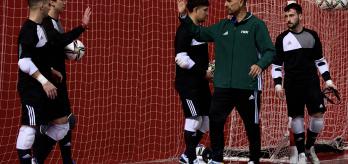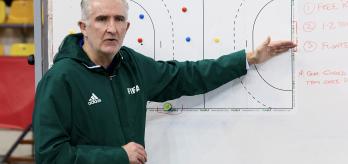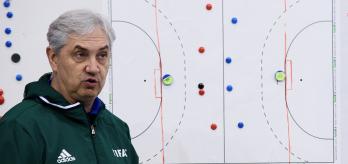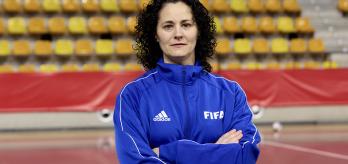Organisation
-
Set up a 15x20m playing area.
-
Place a goal at one end of the playing area.
-
Mark out a dotted line 9m from the goal line using cones.
-
Set up with three goalkeepers: one in goal and the other two (goalkeepers 2 and 3) beside the goal.
-
Give goalkeepers 2 and 3 a ball.
-
Line six attackers up behind the 9m line.
Explanation
-
Goalkeeper 2 rolls the ball towards the first attacker in the queue, who takes a first-time shot on goal from behind the 9m line.
-
The sequence ends when the ball goes out of play, the goalkeeper gains possession or a goal is scored.
-
Once the sequence is over, the goalkeepers rotate positions, with goalkeeper 3 rolling the ball from beside the goal to the second attacker in the queue, goalkeeper 2 taking up a position in goal and goalkeeper 1 occupying a position beside the goal.
-
If the goalkeeper parries the attacker’s shot back out to them, they have a maximum of two touches in which to finish on goal.
Variation 1
-
Introduce a second attacker to the sequence to increase the level of uncertainty for the goalkeeper.
-
The goalkeeper performs lateral movements between the two goalposts (slightly in front of the goal line), touching each of them before becoming active once the attacker receives the ball.
-
If the goalkeeper parries the attacker’s shot back out to them, the second attacker becomes active to create a 2v1 scenario.
Variation 2
-
The attacker has the option to finish on goal or set their team-mate up for a shot on goal.
Variation 3
-
The two attackers can play up to three passes before finishing on goal.
Coaching points
-
The attacker should be alert to any rebounds following their initial shot on goal.
-
The goalkeeper should parry shots into wide areas to avoid presenting the attacker with another shooting opportunity.
-
The goalkeeper should be stationary and anchored to the ground when the attacker shoots at goal.































